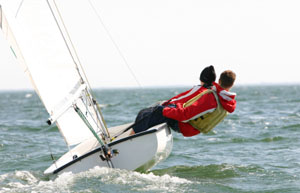
Gybing means changing tacks when the wind is blowing from behind the boat. This can be a difficult manoeuvre in stronger winds, since the wind is blowing directly onto the mainsail throughout the gybe.
In light winds, gibing is easy. Start on a reach and bear away by pulling the tiller towards you. Ease the mainsheet as far as the leeward shroud (at an angle of about 80 degrees to the centreline if you have a no shrouds rig) to allow the boat to bear away. Try to keep the boat flat throughout the manoeuvre. In lighter winds, heeling to windward can help make the boat bear away into the gybe.
Continue to steer carefully through the arc of the gybe with the wind blowing from behind. As soon as the wind starts blowing from the new windward side (the port side if you’ve been sailing on starboard tack and vice versa), it’s time to swing the mainsail across to the new side. On many boats, you can do this by grabbing the ‘falls’ (ropes falling from the boom) of the mainsheet and giving a quick pull.
As soon as the mainsail has swung across the cockpit, straighten the tiller to stop the boat turning. The object is to steady to the boat on a broad reaching course downwind, to ensure it does not heel over with the wind blowing from the new side. The big mistake that many helmsmen make is to allow the boat to continue turning, since the turn develops its own momentum as the boom swings across to the new side. The result is that the boat careers around onto a beam reach, which makes it heel over, while the crew scramble to get their weight onto the new side. This often ends in a capsize.
The helmsmen must steer precisely through the gybe. The technique for crossing the cockpit, while steering the boat, is similar to a tack. Hold the tiller extension with your back hand throughout the gybe, pivoting your body to face forward (in a boat with a centre mainsheet) and swivelling the tiller extension as you cross the cockpit, while holding the mainsheet with your front hand.
Twist your body round to sit on the new windward side deck, with the tiller extension held behind your back so you can keep steering. Use the same technique as a tack to grasp the lower half of the tiller extension with your old sheet hand, flick the tiller extension across your body and grasp the mainsheet with your new front hand.
Modern dinghies with asymmetric spinnakers are designed to be sailed with the centreboards or daggerboard fully down, including during gybes. But with older designs, such as Wayfarer or Enterprise. It’s necessary to gybe with the centreboard partly or fully retracted. This will help prevent the boat from tripping on its foil during the gybe. The same is true of a single handed dinghy such as the Laser – make sure the daggerboard is pulled up halfway during the gybe, but still low enough to be clear of the boom and kicking strap.
If you are sailing a double handed dingy, the crew should move into the cockpit during the gybe, ready to let off the jib and pull in on the new side as the boom swings across the boat. Quick movement of crew weight can be vital to balance the boat when the mainsail powers up on the new side.